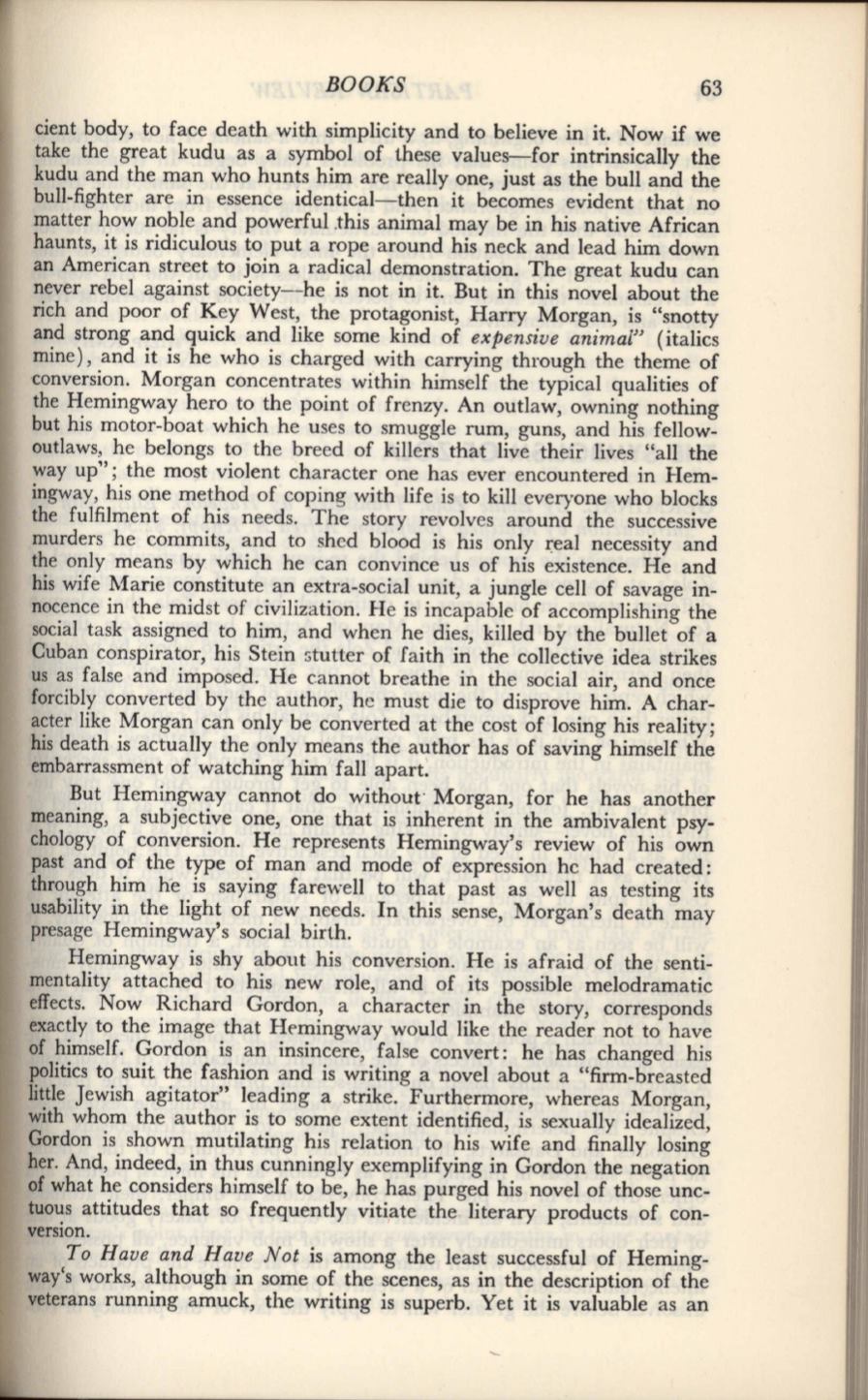
BOOKS
63
cient body, to face death with simplicity and to believe in it. Now if we
take the great kudu as a symbol of these values-for intrinsically the
kudu and the man who hunts him are really one, just as the bull and the
bull-fighter are in essence identical-then it becomes evident that no
matter how noble and powerful .this animal may be in his native African
haunts, it is ridiculous to put a rope around his neck and lead him down
an American street to join a radical demonstration. The great kudu can
never rebel against society--he is not in it. But in this novel about the
rich and poor of Key West, the protagonist, Harry Morgan, is "snotty
and strong and quick and like some kind of
expensive animal"
(italics
mine), and it is he who is charged with carrying through the theme of
conversion. Morgan concentrates within himself the typical qualities of
the Hemingway hero to the point of frenzy. An outlaw, owning nothing
but his motor-boat which he uses to smuggle rum, guns, and his fellow-
outlaws, he belongs to the breed of killers that live their lives "all the
way up"; the most violent character one has ever encountered in Hem-
ingway, his one method of coping with life is to kill everyone who blocks
the fulfilment of his needs. The story revolves around the successive
murders he commits, and to shed blood is his only real necessity and
the only means by which he can convince us of his existence. He and
his wife Marie constitute an extra-social unit, a jungle cell of savage in-
nocence in the midst of civilization. He is incapable of accomplishing the
social task assigned to him, and when he dies, killed by the bullet of a
Cuban conspirator, his Stein stutter of faith in the collective idea strikes
us as false and imposed. He cannot breathe in the social air, and once
forcibly converted by the author, he must die to disprove him. A char-
acter like Morgan can only be converted at the cost of losing his reality;
his death is actually the only means the author has of saving himself the
embarrassment of watching him fall apart.
But Hemingway cannot do without· Morgan, for he has another
meaning, a subjective one, one that is inherent in the ambivalent psy-
chology of conversion. He represents Hemingway's review of his own
past and of the type of man and mode of expression he had created:
through him he is saying farewell to that past as well as testing its
usability in the light of new needs. In this sense, Morgan's death may
presage Hemingway's social birth.
Hemingway is shy about his conversion. He is afraid of the senti-
mentality attached to his new role, and of its possible melodramatic
effects. Now Richard Gordon, a character in the story, corresponds
exactly to the image that H('mingway would like the reader not to have
of himself. Gordon is an insincere, false convert: he has changed his
politics to suit the fashion and is writing a novel about a "firm-breasted
little Jewish agitator" leading a strike. Furthermore, whereas Morgan,
with whom the author is to some extent identified, is sexually idealized,
Gordon is shown mutilating his relation to his wife and finally losing
her. And, indeed, in thus cunningly exemplifying in Gordon the negation
of
what he considers himself to be, he has purged his novel of those unc-
tuo~s attitudes that so frequently vitiate the literary products of con-
versIOn.
To Have and Have Not
is among the least successful of Heming-
way's works, although in some of the scenes, as in the description of the
veterans running amuck, the writing is superb. Yet it is valuable as an


